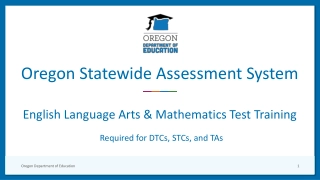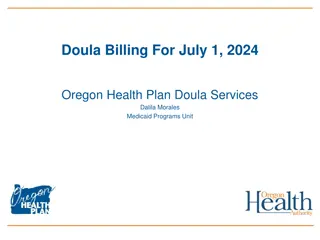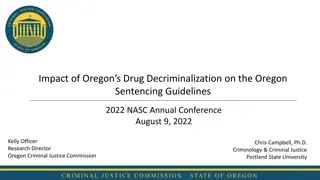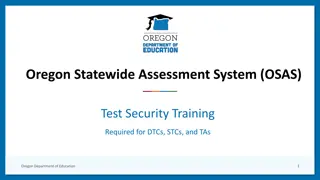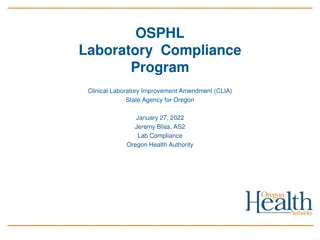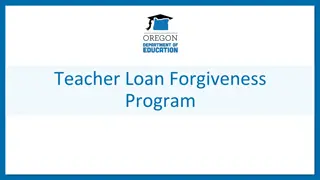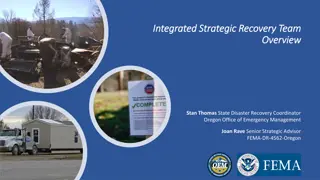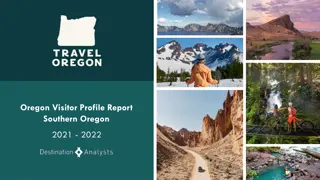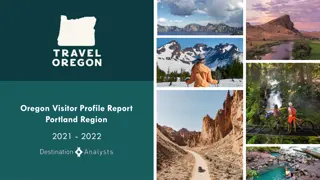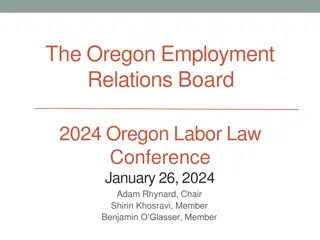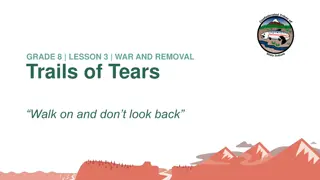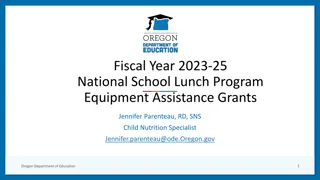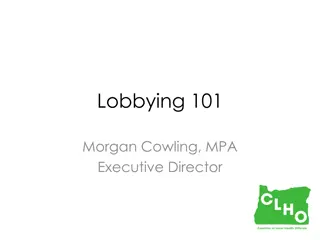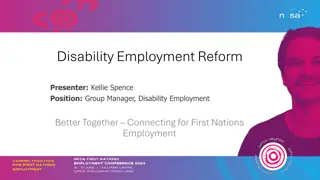Understanding Oregon's Employment First Policy for Integrated Employment
Oregon's Employment First Policy emphasizes the importance of integrated employment for individuals with developmental disabilities. It encourages exploring, pursuing, and maintaining individual, integrated employment opportunities as the primary service option. Key points include the focus on supporting individuals in finding meaningful work and the absence of specific requirements before embarking on the journey towards employment. Efforts are made to understand and address any reservations individuals may have about integrated employment. Tools such as the Employment Discussion Guide play a role in gaining insights into individual perspectives.
Download Presentation

Please find below an Image/Link to download the presentation.
The content on the website is provided AS IS for your information and personal use only. It may not be sold, licensed, or shared on other websites without obtaining consent from the author. Download presentation by click this link. If you encounter any issues during the download, it is possible that the publisher has removed the file from their server.
E N D
Presentation Transcript
My Annual Employment Goals People, Families, Self-Advocates Overview: Overview: The significance of Employment First The significance of Employment First It It s everyone s everyone s job s job The purpose and role of ODDS Employment Services The purpose and role of ODDS Employment Services Selecting employment providers Selecting employment providers What if I am not interested in even exploring individual, integrated employment? What if I am not interested in even exploring individual, integrated employment? Office of Developmental Disability Services, Oregon Department of Human Services September 2015 1
Oregons Employment First Policy For people who successfully achieve the goal of employment in an integrated setting, planning must focus on maintaining employment as well as the consideration of additional career or advancement opportunities. For people not yet achieving employment, annual service planning must include and reflect employment opportunities as the first and priority service option explored. 2
How is Integrated Employment Different Than Sheltered Work? In a typical community business or organization; and The person earns at least minimum wage; and Does not have the effect of isolating individuals receiving waiver services from the broader community of individuals not receiving waiver services.* * Source: Fact Sheet: Summary of Key Provisions of the Home and Community-Based Services (HCBS) Settings Final Rule (CMS 2249-F/2296- F), January 10, 2014, p.2 3
Everything Supports Employment Nursing/ Physical Therapy My Job My Communication Supports Residential Supports Behavior Supports 4
Key Points Individual, integrated employment is the goal of all ODDS employment services. There are no tests to pass or services a person must have before exploring, pursuing and/or obtaining individual, integrated employment. Use resources to make decisions about selecting employment providers such as the data at http://www.oregon.gov/DHS/dd/Pages/index.aspx If someone does not want to explore integrated employment, efforts should be made to understand why and how people of working age arrive at the decision not to explore, pursue, obtain, maintain or advance in individual, integrated employment. The Employment Discussion Guide is one tool that may play a instrumental role in gaining such insight. 5
Key Points We start with the belief that the person can work. Supporting a person to be successful in their employment goals is everyone s job from job coaches to residential staff to their Service Coordinator (SC) or Personal Agent (PA). This expectation must be ingrained into the entire ISP not just the employment sections. Many ODDS employment services are time-limited so it is important that the person s time is invested to realize their employment-related goals. People and families need to understand the array of ODDS employment services that they are eligible for. This is part of Choice Advising. 6
A Brief Overview of ODDS Employment Services Job Coaching: Job Coaching: Individual, integrated employment and earns at least minimum wage. Do not select this service for job coaching provided in Small Group Employment. Small Group Employment: Small Group Employment: Works with a group of 2-8 people with disabilities in an integrated employment setting. Earns at least minimum wage. Discovery/Career Exploration: Discovery/Career Exploration: An opportunity to explore your employment interests. Developing a Discovery Profile. Job Development: Job Development: Help finding a job. Typically funded by VR. Employment Path Community: Employment Path Community: Learning and work experiences to develop skills to realize employment goals. May earn a wage. Employment Path Facility: Employment Path Facility: Same as above, except in a facility setting. 7
The Role of the Career Development Plan (CDP) is to: Clearly communicate what someone wants to happen in regard to employment for their ISP year. It is critical that the person understands that what they select will be the basis for their employment -related supports for the upcoming ISP year. A person is free to change their mind and . A person is free to change their mind and career development goals/plan at any time. career development goals/plan at any time. 8
Making Good Decisions Requires Time & Understanding The best decisions are grounded in recent experiences experiences that are tailored to the interests, skills and abilities of the person This is especially critical for people who decide not to explore, pursue, obtain, maintain or advance in individual, integrated employment. recent 9
The Role of the Employment Discussion Guide To facilitate conversations about individual, integrated employment before the date of the ISP meeting. Opportunities for employment success are exponentially strengthened when a Services Coordinator (SC) or Personal Agent (PA) is an employment champion. Conversations do not substitute for experiences especially for people who are perceived to have the most significant barriers to employment including communication, behavioral or medical challenges. Those experiences must be tailored to the STRENGTHS of the person. 10
Context matters: The guide is only a starting point. To have an impact, conversations and experiences must be tailored to the needs, interests and circumstances of each person. Supplement the guide with other tools that fit each person. What other tools might you use when a person has: Communication Challenges Behavior Challenges Physical Challenges Experiences must be tailored to the unique talents, strengths, abilities and interests of the person. For example, someone who has challenges with hand eye coordination would probably be discouraged and frustrated by an experience assembling small parts. 11
Context matters: The Employment Discussion Guide has four employment paths: Path A: Path A: Working in integrated employment. Path B: Path B: Not working in integrated employment but are interested in exploring it. Path C: Path C: Not working in integrated employment and are unsure about pursuing or exploring it. Path D: Path D: Do not want to work in integrated employment now. Because we begin with a positive assumption that the person wants individual, integrated employment we start the process with Paths B & C in the Employment Discussion Guide, even for people who initially might be inclined to select Path D. Even when a person has selected Path D, it is important to keep in mind that it is never too late for a person to change their mind. 12
Some Ways a PA or a SC Can Be an Employment Champion Describing some of the different jobs the people you support have Discussing the reasons why employment is important Being knowledgeable about the employment track record of providers that serve my community Connecting me with resources such as benefits planning or other supports that could play a crucial role in my employment success such as physical, occupational or behavior services. Helping me to develop strategies to address potential concerns 13
Desired Employment Outcomes For each ODDS employment service selected, the person must choose a provider. It is fine to select the service before choosing the provider. A CDP often spurs people to consider things for the first time. After selecting a provider, the SC or PA will update the CDP. Reviewing the ODDS employment data before selecting a provider (s) may be helpful.* The data is at http://www.oregon.gov/DHS/dd/Pages/index.aspx Examples of how to use this data are in The Employment Discussion Guide as well as the Selecting Employment Providers Guide If a person has employment-related goals but only uses natural supports, use the Desired Employment Outcomes section to clearly describe and plan how such supports will help the person to realize their goals. * Provider refers to organizations that deliver employment services. It also extends to PSWs who provide employment services 14
ODDS Employment Data 100 Total individuals served * 300 Duplicated Count of Services Provided ** 50.00% of individuals are in integrated employment 100.00% survey completion rate Integrated Employment Path to Integrated Employment Day Supports and Activities Employment Programs at a glance Individual Supported Employment Group Supported Employment Employment Path Community Employment Path Facility Non-Work Facility Non-Work Community Discovery Number of Individuals Served: 30 20 0 10 90 80 Average Hours per Month 25 30 0 8 70 25 Average Wage per Hour $9.50 $5.30 NA NA NA NA 15
Sample Questions to Ask When Interviewing Employment Providers What percentage of the people you support have their own, individual, integrated community job? (Do not include people working for the provider, another ODDS provider or a provider-affiliated entity.) 1. Can you name some of the employers people work for? 2. Can you give me a list of job titles? 3. Of the people in #1, what is the average: - Time it took to find the job - Length of time on the job - Average hourly wage - Average number of hours worked per week 4. 16
Sample Questions to Ask When Interviewing Employment Providers 5. How many people with disabilities similar to mine have you been successful in helping to get, maintain and advance in individual, integrated employment? 6. Please describe the challenges and/or specific needs job seekers had when they came to you for assistance. How did you meet these challenges? 7. Would you arrange for me to talk with a couple of people and their families? More sample questions are in The Employment Discussion Guide 17
What if the Person Does Not Want to Even Explore Employment? You and your team need to begin to consider your annual employment goals BEFORE BEFORE your annual ISP is written. Typically done through experiences tailored to the person. Typically done through experiences tailored to the person. At a minimum, we would encourage you to meet with your PA, SC and any other people At a minimum, we would encourage you to meet with your PA, SC and any other people you would like to invite. Using the Employment Discussion Guide, facilitate a discussion you would like to invite. Using the Employment Discussion Guide, facilitate a discussion about employment. Your PA or SC will document the outcome of that discussion on the about employment. Your PA or SC will document the outcome of that discussion on the Person Person- -Centered Information document. Centered Information document. When an adult of working age decides not to explore, pursue, obtain, maintain or advance in individual, integrated employment, this must, at minimum be documented in: Page 3 of the ISP (formerly known as the My Declaration); and Page 3 of the ISP (formerly known as the My Declaration); and The Person The Person- -Centered Information Document; and Centered Information Document; and The One Page Profile; and The One Page Profile; and The Decision not to Explore Employment section of the ISP The Decision not to Explore Employment section of the ISP The four documents described above will be referred to as the Decision not to Explore The four documents described above will be referred to as the Decision not to Explore Employment (DNE) Employment (DNE) 18
The Purpose of the DNE is To: Ensure that you have had an opportunity to make an informed choice about not working including discussion about employment as well as employment-related experiences that may cause you to decide to complete a CDP instead of an DNE. Identify barriers that are keeping you from working with the purpose of generating discussion about solutions and, by doing so, creating an opportunity for you to consider integrated employment. Document why and how you and, if you choose, their ISP team made the decision to complete the DNE rather than the CDP. 19
What if the Person Does Not Want to Even Explore Employment? None of the waiver-funded employment services would be requested. The person may want to consider these K-Plan services: 1. 1. Day Support Activities Community Day Support Activities Community Also referred to as Non-Work Community 2. 2. Day Support Activities Facility Day Support Activities Facility Also referred to as Non- Work Facility 20
Thank You Julie L. Huber Employment Specialist ODDS 503-945-9787 julie.l.huber@state.or.us 21


